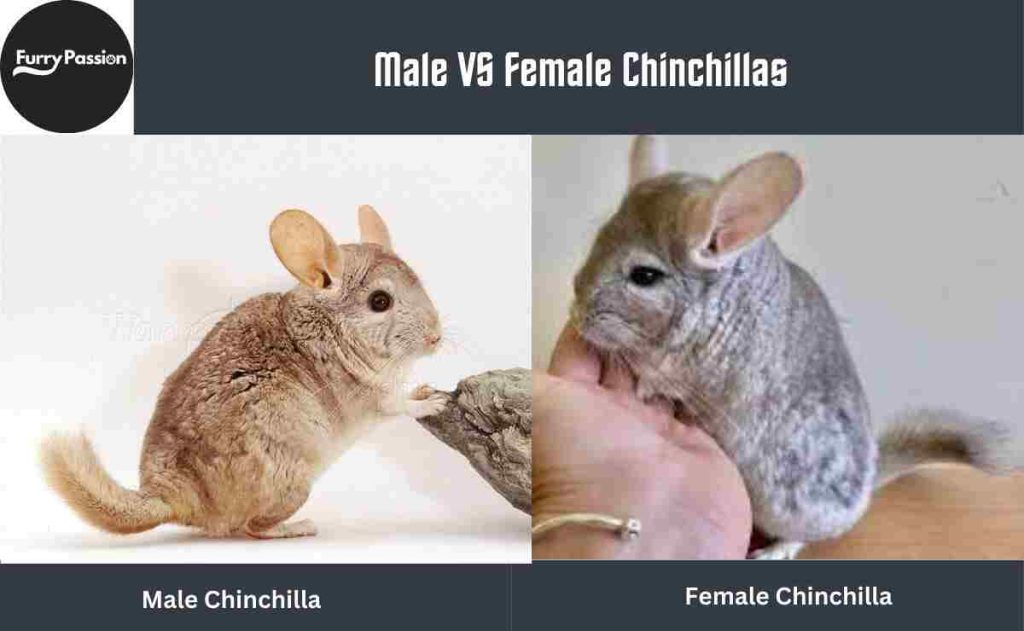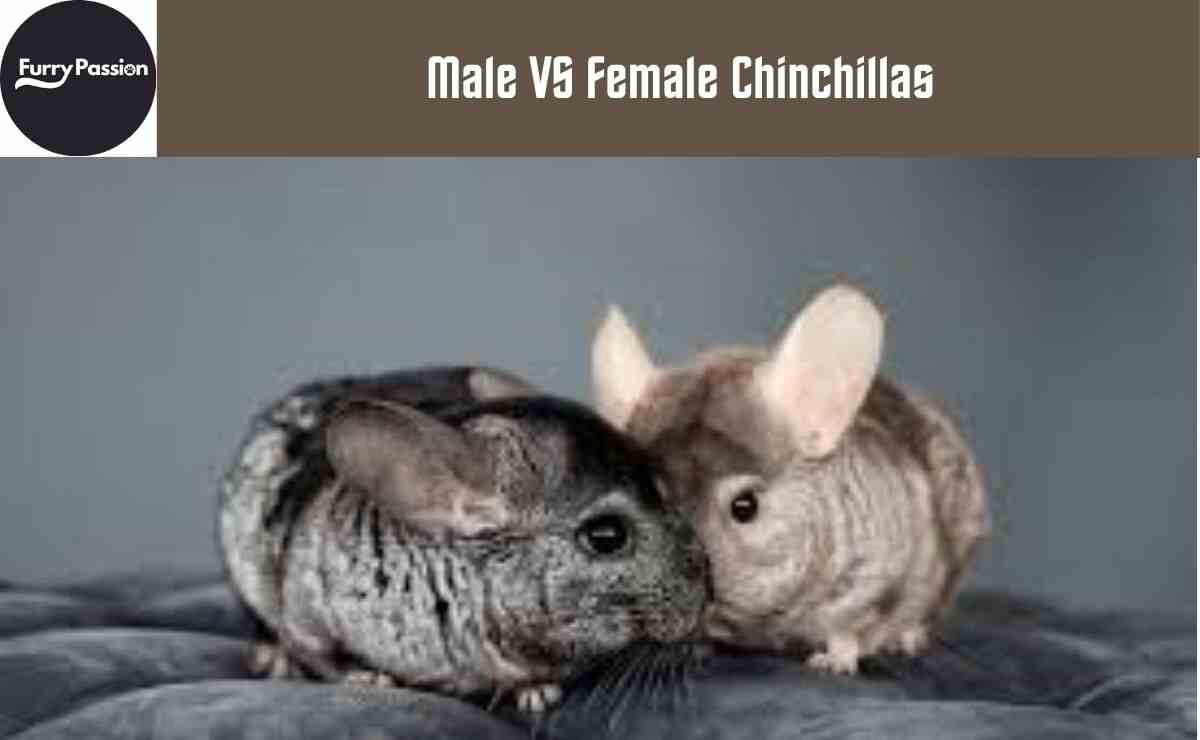Chinchillas are the most adorable, soft, and small rodents with long, dense fur. They are native to South America and have become popular pets around the world. They are also intelligent and have unique personalities.
If you’ve considered keeping chinchillas as pets, you may wonder whether you should choose male or female chinchillas. Though both genders are great pets, there are a few differences. So here is the discussion about male vs female chinchillas that helps you to make better decisions.
Male VS Female Chinchillas

If you’re considering having only one chinchilla as a pet, the choice between genders doesn’t hold significant differences. Both male and female chinchillas are equally suitable for domestic life as cherished companions.
Both genders can establish strong connections with their human caretaker, showing equal affection. You can’t split them in terms of personalities. Still, you can find some notable differences when taking care of it. For example:
- Disposition
The personality strictly depends on the individual chinchillas. Different chinchillas have different activity levels.
Usually female chinchillas are found more active and social. This energy, though, can be tempered when you group them, where they exhibit milder and more sophisticated interactions with fellow female chinchillas.
On the other hand, male chinchillas are somewhat less energetic and calmer.
- Size
In a few species, male chinchillas are larger than females. But in all species, you can see larger female chinchillas than males.
Exploring the weight spectrum of chinchilla species, long-tailed chinchillas typically range between 370 and 490 grams. On the other hand, short-tailed chinchillas weigh between 1.1 and 1.4 kilograms, with one kilogram equal to 1000 grams.
In these weight ranges, females tend to gravitate towards the higher end, while males are on the lighter side.
Whether a larger or smaller chinchilla is preferable, depends on your personal preferences. Though the size disparity isn’t solely attributed to gender; diet plays a pivotal role in a chinchilla’s growth.
A nourishing and well-balanced diet during their developmental stages contributes to reaching their full potential size.
- Neutral Care
When it comes to the care of chinchillas, there is no difference. Both male and female chinchillas require essentially the same level of attention and care.
The primary care elements like dietary needs, temperature, humidity settings, playtime, and attention, remain consistent irrespective of gender.
One notable difference arises concerning the option of neutering. Some owners opt to neuter their male chinchillas; this procedure is not a necessity, especially when keeping two males or two females together.
This strategic pairing eliminates the possibility of unplanned pregnancies, rendering neutering unnecessary in many cases.
However, male chinchillas do face a specific issue known as hair rings, which can occur after mating. This condition involves a small amount of hair getting stuck in the foreskin, potentially causing complications like the inability to mate.
Regular checks for hair rings are crucial, and this issue doesn’t exclusively arise after sexual intercourse. Expert owners can often remove the hair rings, but veterinary assistance is also available.
- Territorial
This is one of the factors that make the difference between male and female chinchillas. This is rooted in the social structure observed in wild chinchillas.
Wild chinchillas form ‘herds,’ ranging from a dozen to even a hundred animals, where females hold the core positions. Consequently, females adopt a more territorial stance, defending the spaces where they find food and establish their presence.
This territorial behavior is often observed in captivity. The female chinchillas exhibit a protective nature over resources such as food, water bottles, and hiding spots. In contrast, males tend to display more amiable traits.
Territorial tendencies are influenced by various factors beyond gender. The size of the cage, the availability of resources, and the chinchilla’s upbringing all play pivotal roles in shaping territorial behavior.
Limited space, competition for food, or a history of neglect during upbringing can induce stress, leading to heightened protective instincts.
- Sociality
All chinchillas are naturally sociable and they live in herds. So it is often recommended to keep them with cage mates so that they can fulfill their inherent need for social interaction.
This theory is the same for both male and female chinchillas. Though you can see some territorial issues in female chinchillas, they often relate to environmental factors.
A too-small cage or insufficient food may trigger territorial behaviors, overshadowing their natural instincts. So both male and female chinchillas are social and great pets.
- Breeding
Breeding chinchillas demands careful consideration and timing to ensure the health and well-being of both the parents and offspring.
Females typically reach sexual maturity between the ages of 4 and 5 months. However, it’s advisable to refrain from breeding them until they are between 8 months to 1 year old.
This waiting period allows them to reach full physical maturity, ensuring they can handle pregnancy and childbirth without complications.
For male chinchillas, the optimal breeding age falls within the first 1-2 years of life. Professionals suggest initiating the breeding process when males are between 7-8 months old, allowing them to reach their prime reproductive age.
Starting the breeding journey before they reach 2 years old ensures optimal fertility and health for successful mating.
Which One Is Better – Male vs Female Chinchilla?

Both male and female chinchillas have their own unique features and characteristics, and the right choice for you will ultimately depend on your personal preferences and circumstances.
Male chinchillas are generally calmer and less territorial, making them a better choice for owners who plan to keep multiple chinchillas together.
Female chinchillas are known for their energy and playfulness, and they tend to establish a stronger bond with their owners. They are sociable but often have territorial issues which can occasionally lead to conflicts with other chinchillas if not properly introduced or housed separately.
However, they can form strong bonds with their owners as well, but their affectionate nature may be more subtle compared to males.
Ultimately, the decision is yours. Yet, you can consider factors such as your experience with chinchillas, the presence of other chinchillas in your home, and the type of relationship you are looking to establish with your pet.
If you are unsure, it may be beneficial to spend some time interacting with both male and female chinchillas to see which one you connect with more.
Can Male And Female Chinchillas Live Together?
It’s fine to keep male and female chinchillas together, but you need to understand the nature and behavior of chinchillas. Eventually, their natural instincts may lead them to engage in mating behavior, eventually resulting in offspring.
That’s why many chinchilla owners opt for same-sex groupings, either two or more males or two or more females, to avoid the challenges associated with unexpected pregnancies. This approach eliminates the concerns related to assisting with the birth process and caring for newborn kits.
If you do plan on keeping male and female chinchillas together, it is recommended to neuter or spay them to minimize aggressive behavior and prevent unwanted pregnancies. Neutering or spaying can also help reduce the risk of certain health issues.
Moreover, provide a spacious and enriched environment for your chinchillas. Chinchillas require plenty of space to exercise and explore, so a large cage with multiple levels and hiding spots is recommended. This helps reduce any potential conflicts and allows each chinchilla to have their own space if needed.
Conclusion
Whether it is male or female, both chinchillas are great options as pets. If you train them properly, they will be your best companion. Regardless of gender, all chinchillas require proper care, attention, and a suitable environment to live.
You should be more careful about providing a balanced diet, and a spacious cage with plenty of room for exercise for your pet chinchillas. These are essential for the health and well-being of your chinchillas.
